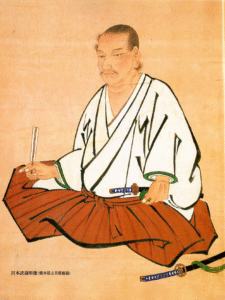
Musashi’s own writings — most composed in the last decades of his life — focus on strategy, martial philosophy, and self-discipline. They are widely studied not just for their martial arts content but for their applicability to strategy, leadership, and personal mastery.
1. The Book of Five Rings (五輪書, Go Rin no Sho) — 1645
• Theme: Strategy, martial philosophy, victory.
• Structure: Five scrolls — Earth, Water, Fire, Wind, and Void — each representing different strategic principles. 
• Why read it: It’s considered one of the greatest manuals on strategy and combat ever written, but also transcends its military roots to offer wisdom on leadership, competition, and self-discipline.
• Tip: Many modern readers find its principles equally useful in business, negotiation, and personal development.
⸻
2. Dokkōdō (道行道, “The Path of Aloneness” / “Way of Walking Alone”) — 1645
• Theme: Minimalist philosophy and self-discipline.
• Content: Only 21 short precepts Musashi wrote a week before his death as a final testament to his disciple. He reflects on detachment from material pursuits, inner resolve, and steadfastness. 
• Why read it: A deeply introspective work, giving a rare glimpse into Musashi’s values: simplicity, independence, and Stoic acceptance.
⸻
3. Hyodokyo (兵道鏡, Mirror of Martial Strategy)
• Theme: Early reflections on combat and strategy.
• Notes: One of his lesser-known works, focusing on the path of martial discipline. It predates The Book of Five Rings. 
⸻
4. Hyoho Sanjugo Kajo (兵法三十五箇条, “Thirty-Five Instructions on Strategy”)
• Aspect: Concise guide to battle tactics — principles he used throughout his dueling career. 
⸻
5. Hyoho Shijuni Kajo (兵法四十二カ条, “Forty-Two Instructions on Strategy”)
• Aspect: A later version of his strategic notes, expanding on the Thirty-Five Instructions. These texts were likely used as teaching tools for young disciples in Musashi’s school. 
⸻
💡 Good tip: The “Complete Musashi” editions (e.g., those translated by Kenji Tokitsu or Alexander Bennett) compile all these works — which is handy if you want them in one volume rather than sourcing each separately. 
⸻
📚 Major Books About Musashi
While the above are real historical texts, several secondary works — some fictional, others biographical — are also worth reading:
• Musashi by Eiji Yoshikawa (1935-1939)
A 900-page classic of Japanese historical fiction dramatizing Musashi’s life and duels. It’s readable and rich with period detail — perfect for those who want to immerse themselves in the samurai era. 
• Miyamoto Musashi: His Life and Writings by Kenji Tokitsu
A scholarly work combining a biography with a modern translation of Musashi’s writings — ideal for anyone looking for historical accuracy and philosophical context. 
• The Complete Musashi by Alexander Bennett
A definitive compilation of Musashi’s works with annotations and historical commentary, offering perhaps the most complete picture of his philosophy and methods today. 
⸻
📖 Reading Tips for Beginners
If you’re new to Musashi’s works:
1. Start with The Book of Five Rings — This is his masterpiece and most influential work.
2. Then read Dokkōdō — Short and powerful, offering deep philosophical insight.
3. Explore the instructional texts (Sanjugo and Shijuni Kajo) for deeper strategic understanding.
4. Finish with a biography or the Yoshikawa novel for historical context and narrative.